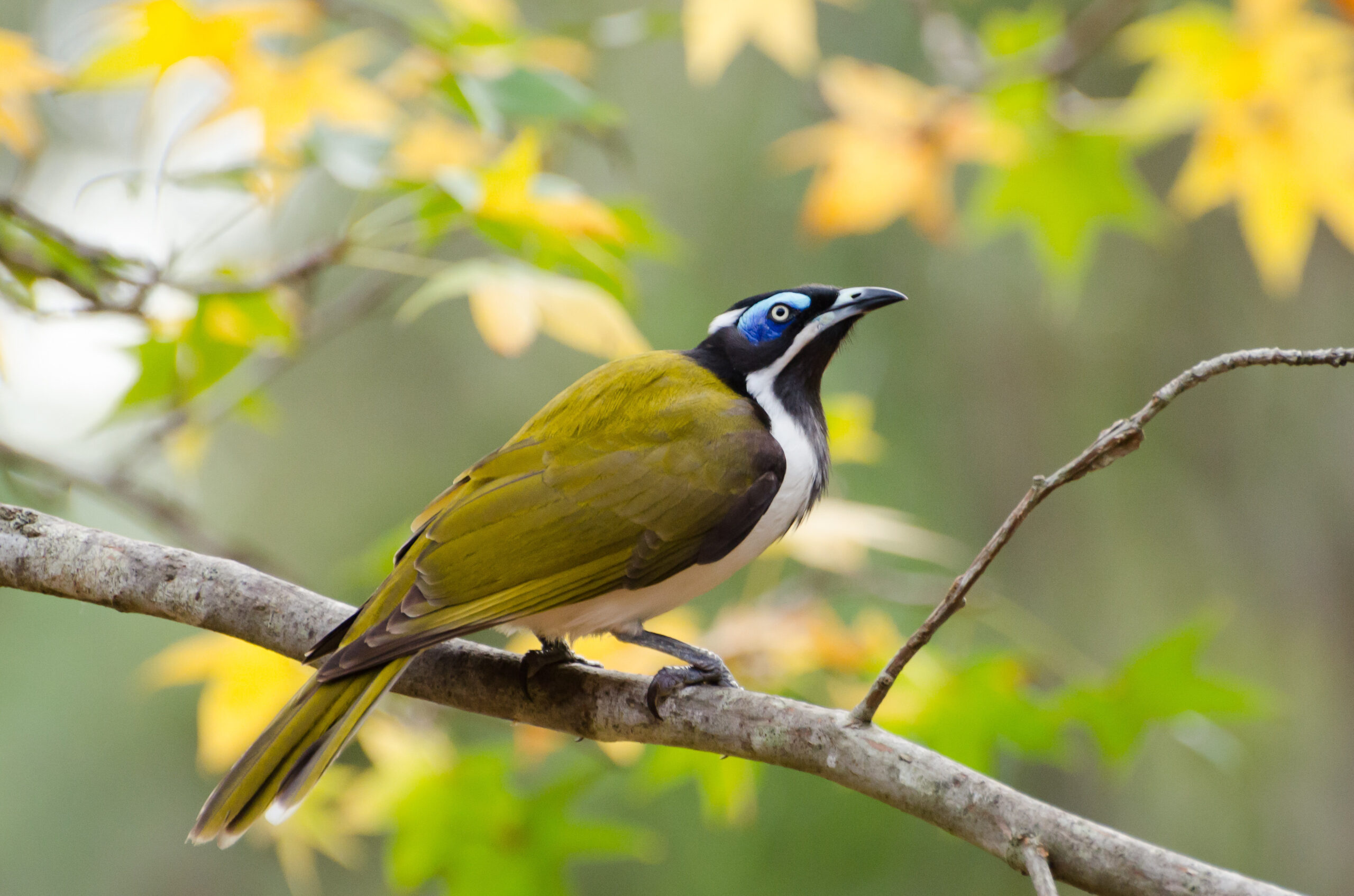Bold, vocal and conspicuously colourful, the Blue-faced Honeyeater (Entomyzon cyanotis) is a familiar sight in northern and eastern Australia’s woodlands, open forests and suburban areas. Nicknamed the “banana bird” for its habit of frequenting flowering and fruiting trees, this species is an important pollinator and an unmistakable member of Australia’s avian community. Its striking facial skin and inquisitive nature make it one of the more recognisable honeyeaters across its broad range.
Identification
A large honeyeater measuring 26-32 cm in length, the Blue-faced Honeyeater is easily identified by the vivid blue patch of bare skin around each eye, which contrasts sharply with its black crown and nape. The upperparts are a soft olive green, while the underparts are mostly white, with a distinctive black bib that runs from the face to the upper chest. Juveniles have duller greenish facial skin and brownish tones to the plumage, lacking the intense contrast of adults. The bill is pale and slightly curved, suited to nectar feeding.
Habitat and Distribution
Entomyzon cyanotis is distributed widely across northern and eastern Australia, including Queensland, New South Wales and the Northern Territory. It inhabits open forests, woodland, paperbark swamps and dry sclerophyll forests, as well as urban parks, gardens and orchards. Its preference for flowering and fruiting trees means it often thrives in modified environments where native and exotic plantings provide a reliable food source. It is less common in the arid interior and rarely occurs in dense rainforest.
Ecological Role
The Blue-faced Honeyeater plays a vital ecological role as both a pollinator and seed disperser. Feeding primarily on nectar, fruits and insects, it visits a wide variety of flowering native species including eucalypts, grevilleas and melaleucas, assisting in the cross-pollination of these plants. Its habit of consuming overripe and fallen fruits also aids in seed dispersal. Insect prey forms a key part of the diet during breeding season, providing essential protein for chicks. This bird’s dynamic feeding behaviour contributes to ecosystem health in both natural and urban environments.
Behaviour and Reproduction
Blue-faced Honeyeaters are active, noisy and highly social, often foraging in pairs or small groups. Their call is a varied mix of harsh chattering, squawks and softer whistles. They can be aggressive around feeding areas and defend key flowering trees from other honeyeaters. Breeding typically occurs from July to February, although timing can vary with rainfall and food availability. Nests are cup-shaped structures built in tree forks and the species is known to nest in close proximity to human activity. Interestingly, older offspring from previous broods sometimes assist in feeding the young – a behaviour known as cooperative breeding.
Conservation Status
The Blue-faced Honeyeater is listed as Least Concern in both Queensland and Western Australia, where it is present in the Kimberley and Pilbara regions. It is widespread, adaptable and has a stable population across much of its range. Its success in modified habitats has buffered it from many of the pressures that affect other woodland bird species.
Threats
Although not currently at risk, localised declines may occur due to the removal of large flowering trees, especially eucalypts, from urban areas and rural properties. Competition with more aggressive honeyeaters such as Noisy Miners (Manorina melanocephala) may exclude them from preferred habitats in some fragmented woodlands. Insecticide use in gardens and orchards can also reduce prey availability or pose poisoning risks. Long-term threats could include climate change impacts on flowering cycles and habitat suitability.
Conservation Efforts
The Blue-faced Honeyeater benefits from broad habitat conservation initiatives aimed at protecting woodland and forest ecosystems. Retention of mature flowering trees in urban design, restoration of native vegetation and public education about bird-friendly gardening all support its continued success. Citizen science programs and bird monitoring initiatives also contribute data on its distribution and behaviour across Australia.
Final Thoughts
With its piercing blue eye-patches, inquisitive nature and loud calls, the Blue-faced Honeyeater is a vibrant ambassador for the health of Australia’s open forests and gardens. Its adaptability and ecological value as a pollinator highlight the importance of maintaining diverse, flowering-rich habitats – both in the bush and within our communities. Celebrating and supporting species like Entomyzon cyanotis helps ensure a future where native wildlife continues to thrive alongside human development.
Fauna Resources specialises in the safe handling of a range of different fauna species, through safe, effective and ethical fauna solutions. By providing dedicated fauna services, through passionate fauna spotter catchers and fauna specialists, we can support the unique terrestrial ecosystems and rich biodiversity Australia has to offer.
For more information about our specialist fauna services contact Fauna Resources today.
